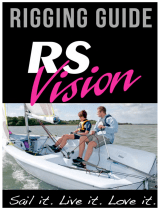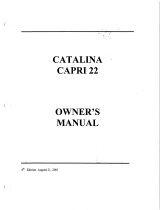Page is loading ...

Access Dinghy Sailing Systems Pty Ltd
2/7 Bungaleen Court
Dandenong South Victoria 3175
Australia
Phone: 61 3 9768 3101
Fax: 61 3 9768 3103
Email: [email protected]
www.accessdinghy.org
USA Fax:
520 563 8203
Important Note:
Whilst Access Dinghies have inherent design features ensuring maximum
stability thereby reducing the chance of capsize, it should be remembered
that these are small sailing dinghies and under certain weather, water and
sailing conditions sensible precautions should be taken :
•
Always reef the sails according to the weather conditions.
•
Always have a manned safety boat in the sailing area.
• Always cancel sailing activities if inclement weather conditions dictate.
The safety of the sailors should come first under all circumstances.
2.3 Specifications
Length 2.3 metres
Beam 1.25 metres
Draft 0.75 metre
Boat Weight 52 kg
Centreboard Weight 22 kg
Sail Plan Cat Rig
Sail Area 3.8 sq. m
Mast 4.1 metre
Access Dinghies
OPERATIONS &
SAFETY MANUAL
Access 2.3
Wide & Single Seater

General info on Personal Floatation Devices
(PFD’s)
There are many types and variety of buoyancy aids available, manufactured
to different sets of standards.
The PFD is a personal item of safety equipment, designed specifically to
assist in preserving a person’s life when in the water. Some PFD’s provides
buoyancy to help you float with your head above the water.
All sailors and volunteers should wear a PFD at all times whilst on, or
near water.
PFD’s are subject to normal wear and tear. Each one should be checked
regularly and if in doubt about its serviceability it should be replaced. If they
become wet from salt water they should be hosed down with fresh water
and allowed to dry.
PFDs and Children
A properly designed PFD of the correct size will keep a child’s mouth and
nose clear of the water. A child should be taught how to put on a device
and should be allowed to try it out in the water. It is important that the child
feels comfortable and knows what the PFD is for and how it functions.
Items included with your Access 2.3 Sailing Dinghy.
1. 2.3 Sailing Dinghy 8. Installed reefing system
2. Mast 9. Bobbin
3. Boom 10. Sail
4. Centreboard 11. Mainsheet
5. Rudder 12. Outhaul
6. Rubber Box 13. Traveller
7. Rudder Box Pin 14. Painter
General Safety Sailing Precautions
GENERAL
•
Take into account the actual and forecast weather conditions.
•
Personal Flotation Devices (PFD) must be worn by all persons when
afloat.
•
The sailing area should be clearly defined and known to all afloat. The
safety boat should be able to view the entire sailing area at all times.
• There should be a simple signal for all boats to return to shore, which is
known by all afloat.
• The safety of sailors and volunteers must be considered at all time. If
weather conditions alter, sails are to be reefed accordingly, or if neces-
sary activities cancelled should conditions prove unsafe.
SAFETY BOAT
• When Access Dinghies are sailed a safety boat should be on the water at
all times, with at least two crew on board. Generally a safety boat should
provide cover for no more than eight dinghies, but prevailing conditions
must be taken into account.
•
Safety boats should carry a first aid kit and should be equipped with radio
communication to the shore.
•
In all planing powerboats, a kill cord should be fitted and used
.
•
All persons in the safety boat must wear an approved buoyancy aid.
•
All safety boat personnel should be instructed on how to reef sails.
•
If an Access Dinghy needs to be towed, it is safer and easier to tie
the dinghy close alongside and remove the rudder blade so that the
dinghy cannot be “steered” in the wrong direction.

Design Features of Access Dinghies
Access Dinghies are designed with a hull form and other features which
combine to give considerable stability. There needs to be a set of rules
which we must follow to continue our excellent safety record and prevent
any accidents. The stability of Access 2.3 and 303 Dinghies is reliant upon
the following factors.
•
SEATING
- Because the placement of sailor’s weight affects stability it is
important that people remain seated low in the boat. We therefore, have
to look at using quick release velcro straps to hold sailors in place, pro-
vided the keel is locked fully down.
•
CENTREBOARDS
- It is most important that the keel be fully down
when sailing. The hole 1/3 down the keel is there purely to facilitate
sailing off a beach, and under no circumstances should people with
disabilities be allowed to sail around with the keel held in this posi-
tion
. There is provision to lock the keel fully down so as even in a
“knock down” it remains in place. It is imperative that the locking pin be
inserted whenever the boat is used. Invariably people sailing the electric
boat need to be strapped into it. Never strap someone into a boat
unless the centreboard locking pin is inserted through the c/b handle.
Locking the keel— Insert the long aluminium pin
through the c/b handle and into the drilled hole in the
console. Push the pin right in so that only the knot at
the end of the rope is visible.
•
REEFING
- Being a displacement type hull extra sail area in strong
winds does not mean more speed, all it does is bury the boat in the wa-
ter and make it more difficult to handle. In a breeze it is always better to
reef to suit the stronger gusts.
If an Access Dinghy needs to be towed, it is safer and easier to tie the din-
ghy close alongside and remove the rudder blade so that the dinghy cannot
be “steered” in the wrong direction.
A pontoon system which will take care of the off the beach keel handling
and transferring problems is available from Access Dinghies.
People with disabilities need the keel down and because many are unable
to raise and lower the keel to improve sailing performance and also unable
to adjust the size of the sail by reefing it is discriminatory to allow abler bods
to make these adjustments during a race.
Parts of an Access 2.3 Dinghy
Reefing line
Rudder
Joystick
Centreboard
Traveller
Boom Mast
Painter
Bobbin
Outhaul
Mainsheet
Traveller

How to Rig an Access 2.3
• STEPPING THE MAST
With the reefing line knot positioned as far as it will go on the port (left) side.
1. Loosen the knob under the console on the reefing drum
2. Carefully step the mast making sure the foot is firmly in the step.
3. With the sail full tighten the knob to lock the reefing drum onto the mast.
•
FITTING THE BOOM
The boom should be kept tidy with no loose ends trailing.
1. Untie and sort out the two ropes.
2. Position the boat facing into the wind.
3. Push the rowlock at the front end of the boom onto the bobbin.
4. Take the outhaul which runs along the boom and shackle it onto the cor-
ner of the sail (called the clew).
5. Pull the sail out to the boom end by pulling the outhaul tail and cleat it at
the front end of the boom.
6. Now sort out the other rope, (called the sheet), and shackle it onto the
rope traveller which runs across at the stern of the boat.
7. The other end of the sheet passes through the sheave on the forward end
of the console. Feed it through so you can work it from the seat.
8. Tie a figure of 8 knot to act as a stopper knot at the end of the sheet..
•
REEFING
: shortening sail area
1. Pull on the port reefing line to reduce sail area
2. Pull the Starboard line to increase sail area.
3. Never pull on and “push” both sides at once.
4. You can put one complete turn of sail around the mast without adjusting
the outhaul.
5. To reef further the outhaul needs to be released to allow the sail to travel
forward along the boom.
6. Conversely, when unreefing, you need to pull on the outhaul.
7. The idea is not to flatten the sail along the boom as it should have enough
slack to form a gentle curve.
•
THE STEERING
1. Make sure the steering lines pass under the joystick correctly.
2. Fit the rudder making sure the rope traveller is above the tiller.
3. Remove the spring clip and pass the clevis pin up through the hole at
the end of the tiller. Re-insert the clip.
4. Fit the alloy joystick extension.
•
LAUNCHING
1. Pass the bow line (called a painter) through the guide ring at the bow
and fasten it around the mast with a bowline. (a knot which is always
easy to untie)
2. Use the short alloy tube to pin the centreboard up when moving the boat
around onshore.
3. Pin the centreboard in the half way position if you need to move the boat
around in shallow water.
4. DO NOT ALLOW ANYONE TO SAIL WITHOUT THE CENTREBOARD
FULLY DOWN OR THEY MAY CAPSIZE..
5. Use the long alloy pin to lock the centreboard down.
6. NEVER USE SEAT BELTS OR HARNESSES UNLESS THE CENTRE-
BOARD IS LOCKED DOWN.
Maximum Weight for Access 2.3
Max weight for Access 2.3 Single Seater = 100Kg/220 Lbs
The stability of an access dinghy relies on the body weight of a sailor be-
ing kept low in the boat, thereby lowering the center of gravity. It is there-
fore recommended that sailors weighing over 100Kg/220Lbs shouldsail
the larger Access 303.
Max weight for Access 2.3 Wide Seater
Solo sailor = 100Kg/220Lbs, Tandem sailors = 120Kg/275Lbs.
The max combined weight of 2 sailors in a 2.3 wide is 120Kg/275Lbs. The
extra weight is permissable as the centre of gravity of 2 sailors is pre-
sumed to be lower than a single sailor of the same combined weight.
/





